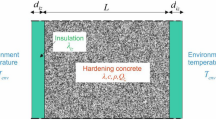Abstract
Thermal cracking has significant impact on the safety and durability of mass concrete. This paper aims to find the reason for cracking of a prototype bridge structure and consider which influencing factors are the most important. For this model experiments on mass concrete in bridge structures were designed and conducted and thermally cracking was induced. Fiber bragg grating sensors were used to monitor the temperature and strain within concrete in real time, as well as the strain around the embedded cooling pipes. Thermal properties of concrete were deduced from these monitoring data and then used in the numerical analyses to verity the calculation accuracy. In the context of engineering practice, the primary influencing factors on the cracking of mass concrete were investigated by numerical analyses. The optimized temperature control methods were proposed to prevent the occurrence of thermal cracking of mass concrete.
Similar content being viewed by others

References
American Concrete Institute (ACI). (2005a). “Guide to mass concrete.” ACI207.1R-05, ACI Committee 207, Farmington Hills, MI.
American Concrete Institute (ACI). (2005b). “Cooling and insulating systems for mass concrete.” ACI 207.4R-05, ACI Committee 207, Farmington Hills, MI.
American Concrete Institute (ACI). (2007). “Report on thermal and volume change effects on cracking of mass concrete.” ACI 207.2R-07, ACI Committee 207, Farmington Hills, MI.
American Concrete Institute (ACI). (2010). “Specifications for structural concrete.” ACI 301-10, ACI Committee 301, Farmington Hills, MI.
Amin, M. N., Kim, J. S., Lee, Y., and Kim, J. K. (2009). “Simulation of the thermal stress in mass concrete using a thermal stress measuring device.” Cement and Concrete Research, pages 154–164.
Bagchi, A., Murison, E., Mufti, A. A., and Noman, A. S. (2010). “Evaluation of a rugged FBG strain sensor system for monitoring reinforced concrete structures.” Experimental Techniques, Vol. 34, Issue 2, pp. 49–53.
Ballim, Y. (2004). “A numerical model and associated calorimeter for predicting temperature profiles in mass concrete.” Cement and Concrete Composites, pp. 695–703.
Bobko, C., Edwards, A., Seracino, R., and Zia, P. (2014). “Thermal cracking of mass concrete bridge footings in coastal environments.” Journal of Performance of Constructed Facilities, DOI: 10.1061/(ASCE)CF.1943-5509.0000664.
Cao, Z., Su, S., and Gu, S. (2012). “Methods for preventing structural cracks in mass concrete pouring for subway construction.” Civil Engineering and Urban Planning 2012, pp. 382–386, DOI: 10.1061/9780784412435.068.
Chu, I., Lee, Y., Amin, M. N., Jang, B. S., and Kim, J. K. (2013). “Application of a thermal stress device for the prediction of stresses due to hydration heat in mass concrete structure.” Construction and Building Materials, pp. 192–198.
Dolen, T. (2010). “Advances in mass concrete technology-the hoover dam studies.” Hoover Dam, pp. 58–73, DOI: 10.1061/41141(390)5.
Guru, P., Sharath, U., Nagarjun, V., Hegde, G. M., and Asokan, S. (2013). “Measurement of temperature and pressure on the surface of a blunt cone using FBG sensor in hypersonic wind tunnel.” Measurement Science and Technology.
Lin, P., Li, Q. B., and Jia, P. Y. (2014). A Real-Time Temperature Data Transmission Approach for Intelligent Cooling Control of Mass Concrete, Advances in Materials Science and Engineering.
Liu, X. H., Zhang, C., Chang, X. L., Zhou, W., Cheng, Y. G., and Duan Y. (2015). “Precise simulation analysis of the thermal field in mass concrete with a pipe water cooling system.” Applied Thermal Engineering, pp. 449–459.
Qian, C. and Gao, G. (2012). “Reduction of interior temperature of mass concrete using suspension of phase change materials as cooling fluid.” Construction and Building Materials, pp. 527–531, DOI: 10.1016/j.conbuildmat.2011.06.053.
Ren, L., Jia, Z. G., Li, H. N., and Song, G. B. (2014). “Design and experimental study on FBG hoop-strain sensor in pipeline monitoring.” Optical Fiber Technology, Vol. 20, Issue 1, pp. 15–23.
Rodriguez, C., Cavadas, F., Félix, C., and Figueiras, J. (2012). “FBG based strain monitoring in the rehabilitation of a centenary metallic bridge.” Engineering Structures, Vol. 44, pp. 281–290.
Shi, N. N., Ouyang, J. S., Zhang, R. X., and Huang, D. H. (2014). “Experimental study on Early-Age crack of mass concrete under the controlled temperature History.” Advances in Materials Science and Engineering.
Shu, X. W., Sugden, K., and Bennion, I. (2010). “Single uniform FBG for simultaneous measurement of liquid level and temperature.” Measurement Science and Technology.
Song, D. W., Chai, Q., Liu, Y.L., Jiang, Y., Zhang, J. Z., Sun, W. M., Yuan, L. B., John, C., and Peng, G. D. (2014). “A simultaneous strain and temperature sensing module based on FBG-in-SMS.” Measurement Science and Technology.
Song, Z. W., Xiao, J. Z., and Zhao, Y. (2010). “Back-Analysis is of concrete thermal parameters based on experimental measurements.” Journal of Tongji University (Natural Science), Vol. 38, Issue 1, pp. 35–38.
Tu, D., Adrian, L., Mang, T., and Michael, B. (2014) “Determination of required insulation for preventing early-age cracking in mass concrete footings.” Transportation Research Record: Journal of the Transportation Research Board, DOI: 10.3141/2441-12.
Wu, X. H. and Wu, Z. R. (2001). “Inverse analysis model of concrete thermal parameters.” Water Power.
Yang, J., Hua, Y., Zuo, Z., Jin, F., and Li, Q. B. (2012). “Thermal analysis of mass concrete embedded with double-layer staggered heterogeneous cooling water pipes.” Applied Thermal Engineering, pp. 145–156.
Zhao, M., He, T., and Li, J. (2005). “The application of the fiber bragg grating sensors in the temperature monitoring of the large volume concrete foundation.” Journal of Experimental Mechanics.
Zhou, Y. C., Bai, L., Yang, S. Y., and Chen, G. T. (2012). “Simulation analysis of mass concrete temperature field.” Procedia Earth and Planetary Science (2012), pp. 5–12.
Zhu, B. F. (2003). “Thermal stressed and temperature control of mass concrete.” China Electric Power Press, Beijing, China.
Author information
Authors and Affiliations
Corresponding author
Rights and permissions
About this article
Cite this article
Yu, X., Chen, J., Xu, Q. et al. Research on the Influence Factors of Thermal Cracking in Mass Concrete by Model Experiments. KSCE J Civ Eng 22, 2906–2915 (2018). https://doi.org/10.1007/s12205-017-2711-2
Received:
Accepted:
Published:
Issue Date:
DOI: https://doi.org/10.1007/s12205-017-2711-2



